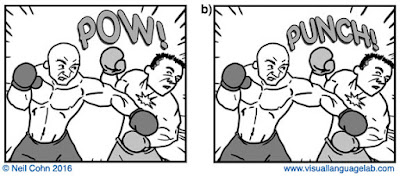New paper: Pow, punch, pika, and chu
The biggest finding in American comics was that onomatopoetic sound effects (Pow!) are used in much greater proportion than descriptive sound effects (Punch!). In fact, though we found some descriptive sound effects in genres of “Independent” comics, we found none in the 10 superhero comics that were analyzed.
In Japanese manga, we found slightly different results. We categorized two types of “sound” effects in manga. Giongo are hearable sounds (crack!) while gitaigo are unhearable qualities (sparkle!). We found that shonen manga used more giongo than gitaigo, while shojo manga had the opposite trend: they used more gitaigo than giongo. In addition, these sound effects in shonen manga were more often written in the katakana script than hiragana, while the reverse occurred for shojo manga.
Overall, our results suggested that different types of comics can be characterized by the way they use “sound effects.”
You can download the paper here, or at my downloadable papers page.
Here’s Nimish speaking about the project at this past ComicCon (unfortunately cut just slightly short by time):
Abstract:
As multimodal works, comics are characterized as much by their use of language as by the style of their images. Sound effects in particular are exemplary of comics’ language-use, and we explored this facet of comics by analyzing a corpus of books from genres in the United States (mainstream and independent) and Japan (shonen/boys’ and shojo/girls’). We found variation between genres and between cultures across several properties of the content and presentation of sound effects. Foremost, significant differences arose between the lexical categories of sound effects (ex. onomatopoetic: Pow! vs. descriptive: Punch!) between genres within both culture’s works. Additionally, genres in Japanese manga vary in the scripts used to write sound effects in Japanese (hiragana vs. katakana). We argue that, in English, a similar function is communicated through the presence or absence of textual font stylization. Altogether, these aspects of variation mark sound effects as important carriers of multimodal information, and provide distinctions by which genres and cultures of comics can be distinguished.
Reference:
Pratha, Nimish K., Natalie Avunjian, and Neil Cohn. 2016. Pow, punch, pika, and chu: The structure of sound effects in genres of American comics and Japanese manga. Multimodal Communication. 5(2): 93-109.

Comments